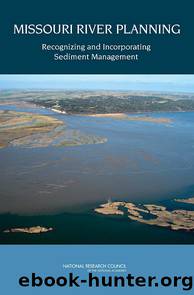Missouri River Planning: Recognizing and Incorporating Sediment Management by National Research Council of the National Academies

Author:National Research Council of the National Academies
Language: eng
Format: epub
Tags: Earth Sciences : Ecology and Ecosystems. Earth Sciences : Water and Hydrology. Earth Sciences : Natural Resources and Conservation. Environment and Environmental Studies : Ecology and Ecosystems. Environment and Environmental Studies : Sustainable Development
Publisher: NATIONAL ACADEMIES PRESS
Published: 2011-02-24T00:00:00+00:00
Emergent Sandbar Habitat
In response to the 2000/03 Biological Opinion, the Emergent Sandbar Habitat (ESH) program was initiated in 2004. The project area extends from Garrison Dam in North Dakota downstream to Sioux City, Iowa. The ESH project areas include reservoir reaches and remnant floodplain areas, including the National Park Serviceâs Missouri National Recreational River in Nebraska and South Dakota. The endangered least tern and piping plover depend on bare sandbars for successful nesting and fledgling (USFWS, 2003). Because such habitat is limited along the river, and because bare sandbars will become vegetated without scouring flows, the Corps of Engineers is increasing the extent of ESH by creating new sandbars largely from dredged material and by clearing vegetation from existing sandbars. The removal of early-succession woody vegetation from sandbars to provide habitat for terns and plovers may conflict with other Corps of Engineers programs to enhance cottonwood forest establishment on islands and floodplains, and the Corps has recognized the need to coordinate this program with its other programs that enhance cottonwood forest established on islands and floodplains (USACE, 2010b).
River sandbars are labile landforms created in disturbed environments. Their morphology fluctuates with cycles of erosion and deposition, and even without erosion or deposition their surface area alternates between aquatic and terrestrial environments as river stage fluctuates seasonally. Hydrogeomorphic processes of flow, sediment erosion, and deposition provide disturbance mechanisms that strongly affect the rate at which a sandbar becomes a permanent vegetated island (Corenblit et al., 2007).
Sandbars provide the environmental conditions for vegetation establishment (Dixon, 2003; Gurnell and Petts, 2002; Johnson, 2000). However, bare sandbars also contribute unique ecological value to a diversity of biota within the active channel of large rivers. Exposed bare substrate characteristic of sandbars is important to nesting riverine turtles (Plummer, 1977) and roosting (Kinzel et al., 2009) and nesting birds (Smith and Renken, 1991), and shorebirds use recently exposed sandbar shorelines for feeding. As described in Chapter 2, the preregulation Missouri River channel was characterized during summer by large expanses of shifting, open, unvegetated sandbars or emergent sandbar habitat. This habitat is important for nesting and foraging by the two endangered bird species on the Missouri River today, the interior least tern and the northern Great Plains population of piping plovers.
An important issue in the context of this report is how the construction of sandbars affects the sediment regime of the river. When emergent sandbar habitat material is derived from the river bed, there is no net impact on the river sediment budget. Over a few years, the bar will be eroded and the sediment will reenter the river bed. This change takes place against the backdrop of reduced sediment transport in the twentieth century due to both sediment storage behind the dams and to stabilization of formerly temporary storage sites, such as bars and banks, due to reduced cut-and-fill alluviation associated with flood cessation and reduction (NRC, 2002).
Under the 2003 Amendment to the Biological Opinion, the Corps is required to maintain specified acreages of natural sandbar habitat âthrough flow regulation or other meansâ (USFWS, 2003, p.
Download
This site does not store any files on its server. We only index and link to content provided by other sites. Please contact the content providers to delete copyright contents if any and email us, we'll remove relevant links or contents immediately.
| Acoustics | Bridges |
| Earthwork Design | Environmental |
| Fire Science | Highway & Traffic |
| Hydrology | Remote Sensing |
| Seismic Design | Structural |
| Structural Dynamics | Surveying & Photogrammetry |
| Transportation |
Whiskies Galore by Ian Buxton(41941)
Introduction to Aircraft Design (Cambridge Aerospace Series) by John P. Fielding(33095)
Small Unmanned Fixed-wing Aircraft Design by Andrew J. Keane Andras Sobester James P. Scanlan & András Sóbester & James P. Scanlan(32767)
Craft Beer for the Homebrewer by Michael Agnew(18200)
Turbulence by E. J. Noyes(7983)
The Complete Stick Figure Physics Tutorials by Allen Sarah(7339)
Kaplan MCAT General Chemistry Review by Kaplan(6903)
The Thirst by Nesbo Jo(6882)
Bad Blood by John Carreyrou(6584)
Modelling of Convective Heat and Mass Transfer in Rotating Flows by Igor V. Shevchuk(6408)
Learning SQL by Alan Beaulieu(6239)
Weapons of Math Destruction by Cathy O'Neil(6220)
Man-made Catastrophes and Risk Information Concealment by Dmitry Chernov & Didier Sornette(5958)
Digital Minimalism by Cal Newport;(5707)
Life 3.0: Being Human in the Age of Artificial Intelligence by Tegmark Max(5519)
iGen by Jean M. Twenge(5387)
Secrets of Antigravity Propulsion: Tesla, UFOs, and Classified Aerospace Technology by Ph.D. Paul A. Laviolette(5336)
Design of Trajectory Optimization Approach for Space Maneuver Vehicle Skip Entry Problems by Runqi Chai & Al Savvaris & Antonios Tsourdos & Senchun Chai(5040)
Pale Blue Dot by Carl Sagan(4960)
